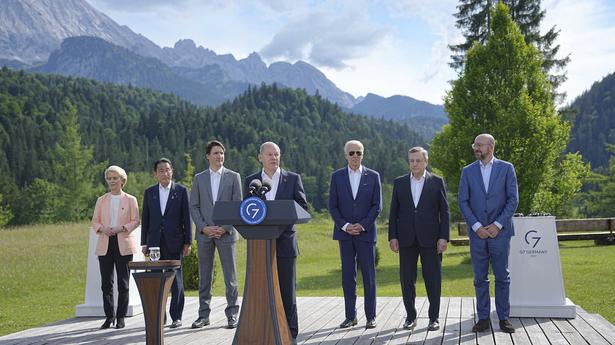
Explained | The G7 plan to counter the Belt and Road initiative
The Hindu
How is the Partnership for Global Infrastructure and Investment going to enhance development in low and middle income countries?
The story so far: On June 26, U.S. President Joe Biden along with his G7 allies unveiled the ambitious Partnership for Global Infrastructure and Investment (PGII), announcing the collective mobilisation of $600 billion by 2027 to deliver “game-changing” and “transparent” infrastructure projects to developing and middle-income countries. The PGII is being seen as the G7’s counter to China’s multi-trillion dollar Belt and Road Initiative (BRI) to build connectivity, infrastructure, and trade projects in Asia, Europe, Africa, and Latin America.
The West has been sceptical of the BRI, since it was launched in 2013 by President Xi Jinping, as it was considered to be part of China’s larger strategy to increase geopolitical influence in Asia and other developing countries. The U.S., along with G7 partners the U.K., Japan, France, Canada, Germany, Italy, and the European Union (EU), had in 2021 announced the launch of the Build Back Better World (B3W) with the aim of narrowing the $40 trillion infrastructure gap in the developing world. PGII is therefore, a relaunch of Mr. Biden’s B3W plan.
The factsheet put out by the White House described the PGII as a “values-driven, high-impact, and transparent infrastructure partnership to meet the enormous infrastructure needs of low and middle-income countries and support the United States’ and its allies’ economic and national security interests”. The G7 members aim to collectively mobilise $600 billion by 2027 to invest in sustainable and quality infrastructure projects in developing countries, including India, and strengthen global supply chains. Mr. Biden announced the country’s pledge to channel $200 billion in grants, public financing, and private capital over the next five years for the PGII. European Commission President Ursula von der Leyen declared Europe’s pledge of mobilising 300 billion euros for the partnership over the same period.
Also read: Group of Seven | Reviving the spirit of multilateralism
All PGII projects will be driven by “four priority pillars that will define the second half of the 21st century”. First, the G7 grouping aims to tackle the climate crisis and ensure global energy security through clean energy supply chains. Second, the projects will focus on bolstering digital information and communications technology (ICT) networks facilitating technologies such as 5G and 6G internet connectivity and cybersecurity. Third, the projects aim to advance gender equality and equity, and lastly, to build and upgrade global health infrastructure.
Mr Biden announced the flagship projects for PGII that have either commenced or are set to begin. The U.S International Development Finance Corporation (DFC), along with the G7 nations and the EU are disbursing a $3.3 million technical assistance grant to build a vaccine facility in Senegal, having a potential yearly capacity of manufacturing “millions of doses of COVID-19 and other vaccines”. Ms. Leyen said that the European Commission’s Global Gateway initiative is also undertaking projects supporting the PGII such as mRNA vaccine plants in Latin America and a fibre-optic cable linking Europe to Latin America among others.
In India, the U.S. DFC will invest up to $30 million in Omnivore Agritech and Climate Sustainability Fund 3, an impact venture capital fund that invests in entrepreneurs building the future of agriculture, food systems, climate, and rural economy in India.





















 Run 3 Space | Play Space Running Game
Run 3 Space | Play Space Running Game Traffic Jam 3D | Online Racing Game
Traffic Jam 3D | Online Racing Game Duck Hunt | Play Old Classic Game
Duck Hunt | Play Old Classic Game











